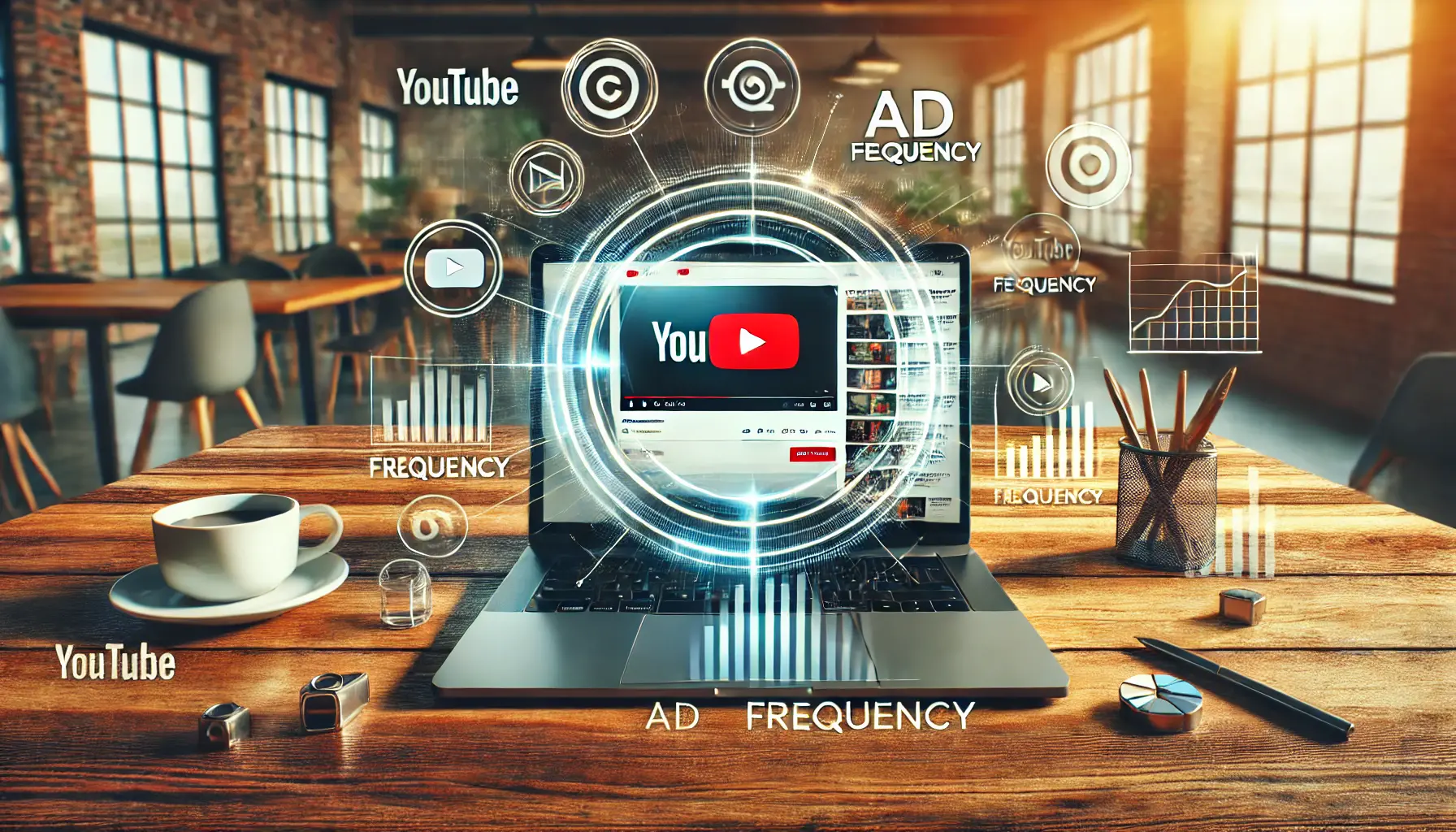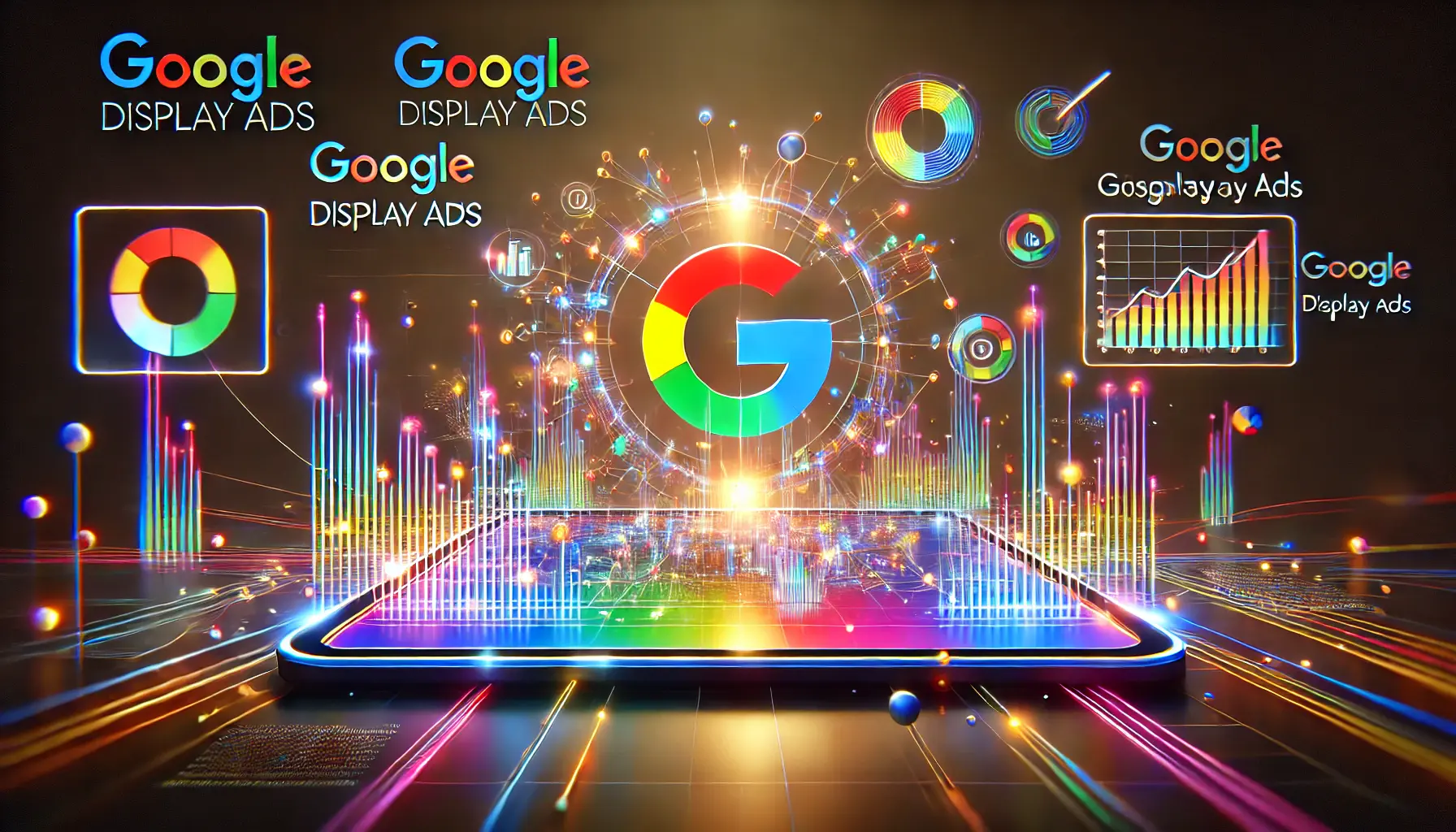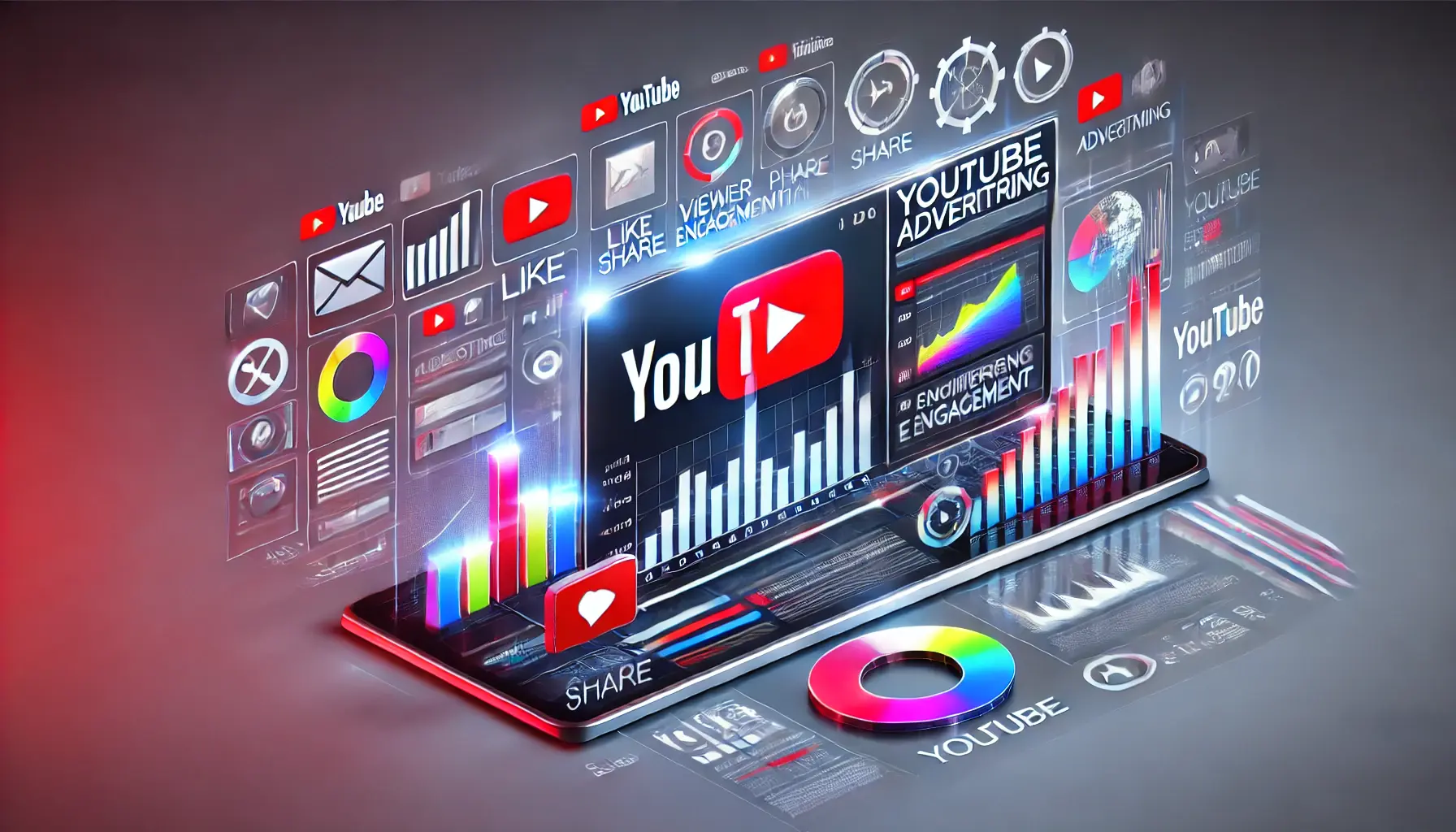In today’s digital age, YouTube has become a cornerstone of online entertainment and information.
As an advertiser, understanding how often your ads appear to viewers—known as ad frequency—is crucial.
Striking the right balance can enhance viewer engagement, while overexposure may lead to annoyance.
Let’s delve into the significance of ad frequency on YouTube and how it impacts both advertisers and viewers.
- Understanding Ad Frequency on YouTube
- Optimal Ad Frequency Strategies for Advertisers
- Tools and Techniques for Managing Ad Frequency
- Case Studies: Effective Ad Frequency Management on YouTube
- Future Trends in YouTube Ad Frequency Management
- Conclusion: Mastering Ad Frequency for YouTube Success
- YouTube Ad Frequency: Frequently Asked Questions
Understanding Ad Frequency on YouTube
Ad frequency refers to the number of times a viewer is exposed to the same advertisement within a specific period.
On YouTube, managing this frequency is vital to maintain a positive user experience and achieve advertising goals.
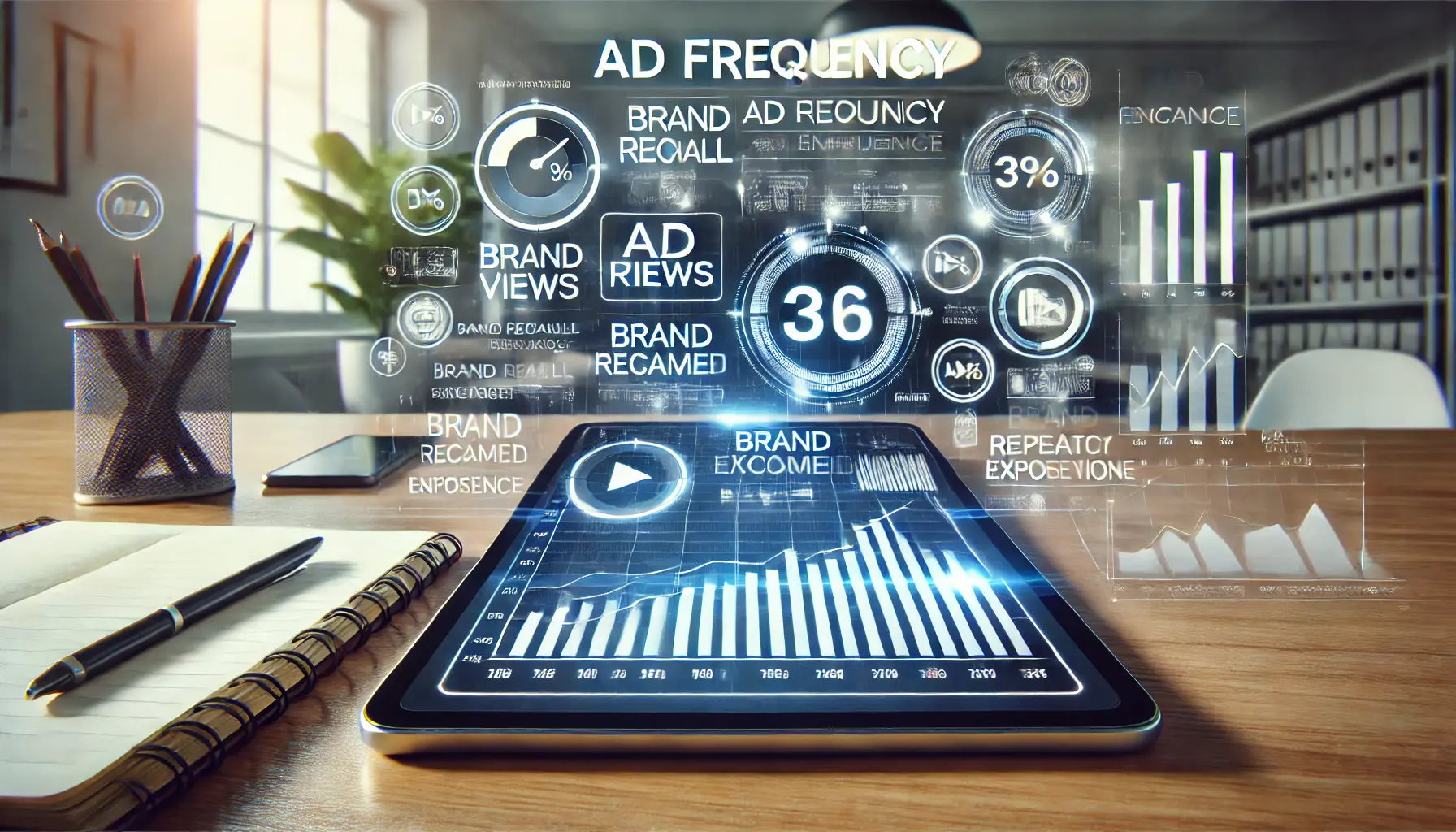
Visual representation of ad frequency and its importance in digital marketing strategies.
Definition and Importance of Ad Frequency
Ad frequency is a metric that tracks how often an individual viewer sees a particular ad.
Maintaining optimal ad frequency ensures that your message is effectively communicated without overwhelming the audience.
- Brand Recall: Repeated exposure can enhance brand recognition.
- Viewer Fatigue: Excessive repetition may lead to viewer irritation.
- Cost Efficiency: Proper frequency management can optimize advertising budgets.

Illustration of how ad frequency influences viewer engagement and retention.
Impact on Viewer Engagement and Retention
Ad frequency directly influences how viewers interact with content.
A well-balanced frequency can lead to higher engagement, while too many ads may cause viewers to disengage.
- Increased Engagement: Appropriate ad frequency can boost viewer interaction.
- Ad Fatigue: Overexposure may result in viewers skipping ads or leaving the platform.
- Retention Rates: Balanced ad frequency helps maintain audience retention.
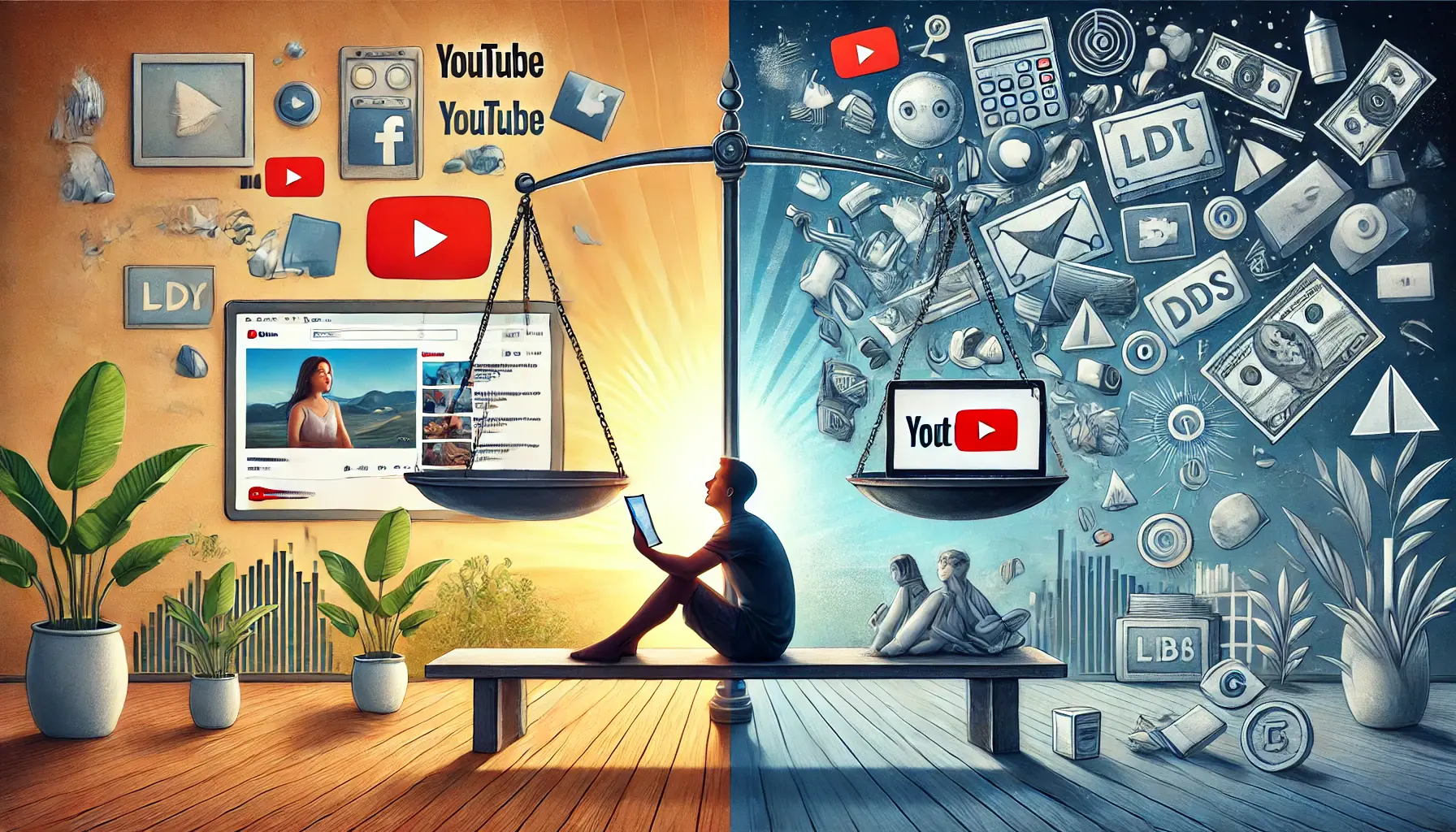
Visual depiction of the balance between ad exposure and user experience in digital advertising.
Balancing Ad Exposure and User Experience
The sweet spot in ad frequency is where the user experience is not marred.
YouTube provides tools for advertisers to control the frequency of their ads to the same user.
- Frequency Capping: Setting limits on ad exposures to avoid overexposure.
- Target Frequency Tools: Leveraging YouTube tools to manage ad frequency efficiently.
- Monitoring Metrics: Regularly adjusting ad frequency based on ongoing performance data.
By understanding and managing ad frequency on YouTube, advertisers can create more effective campaigns that resonate with viewers without causing annoyance.
This balance is key to achieving marketing objectives while maintaining a good relationship with the audience.
Managing ad frequency effectively is essential for a positive user experience and achieving advertising goals. Finding the right balance prevents viewer fatigueA condition where viewers lose interest or become irritated due to excessive or repetitive content. and enhances brand recall.
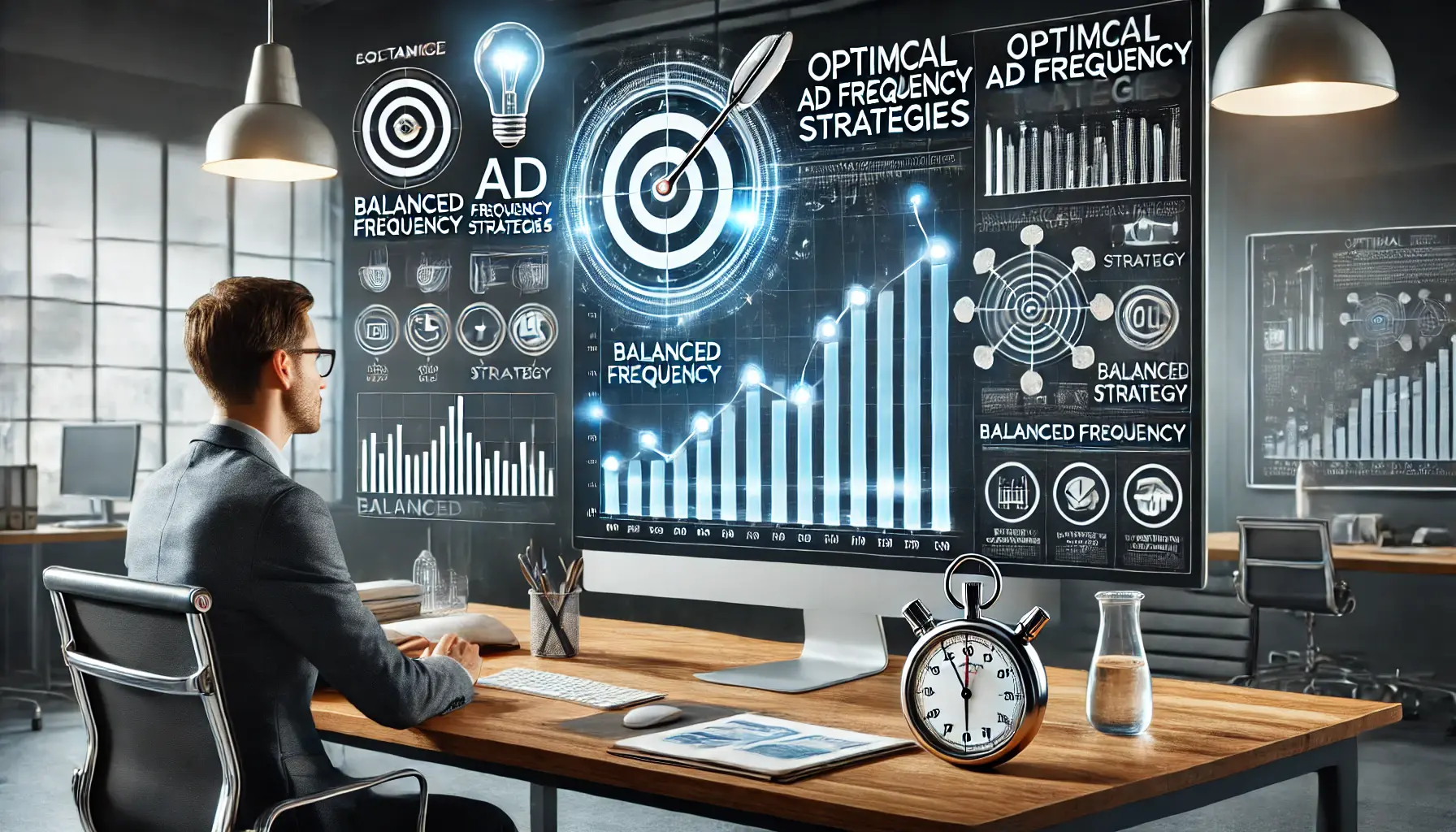
Illustration of strategies for achieving optimal ad frequency in digital advertising.
Optimal Ad Frequency Strategies for Advertisers
As an advertiser, finding the right balance in ad frequency is crucial.
Too few exposures may lead to missed opportunities, while too many can cause viewer fatigue.
Let’s explore strategies to determine and implement optimal ad frequency for your YouTube campaigns.
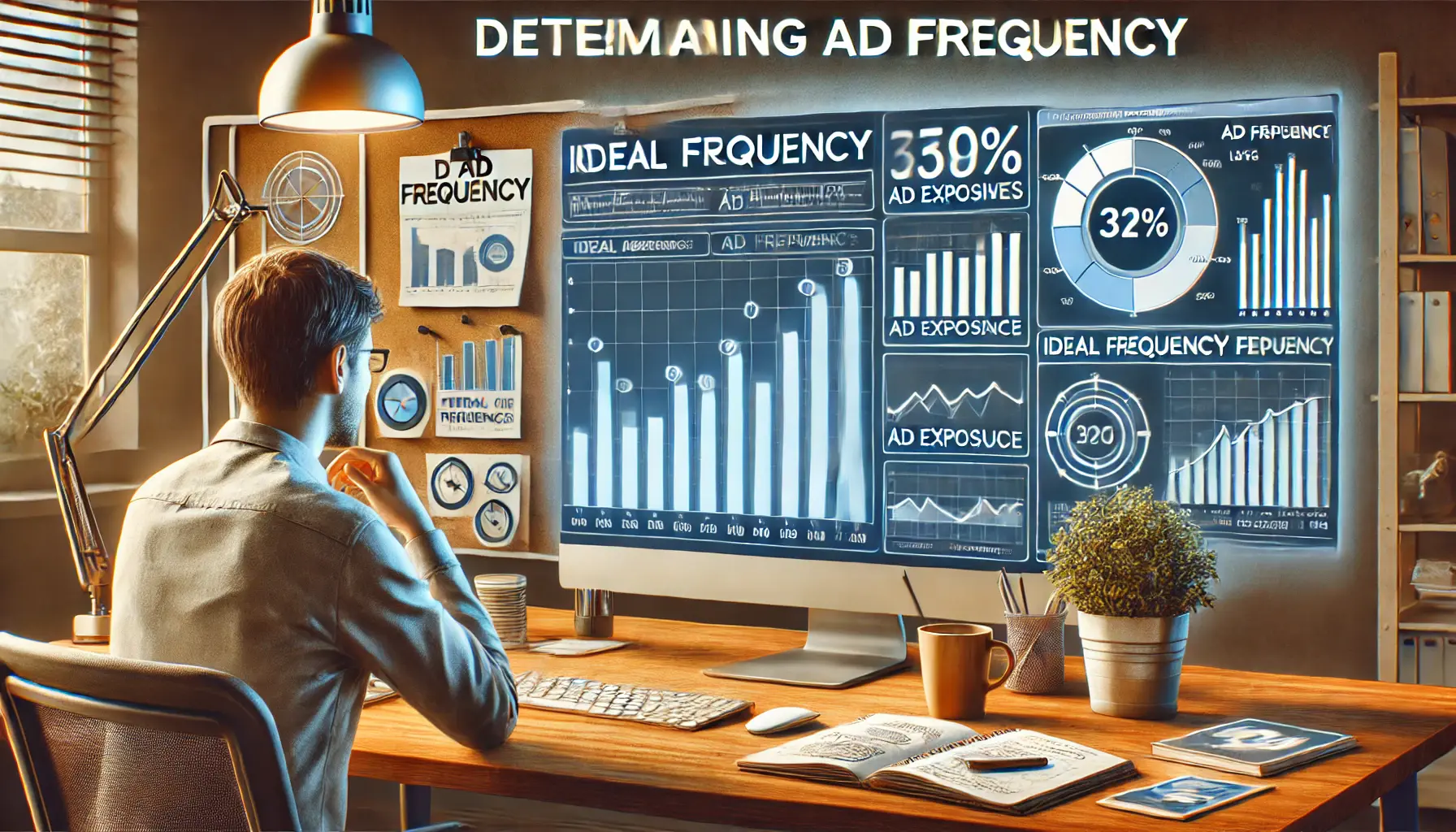
Visualization of the process involved in determining the ideal ad frequency for campaigns.
Determining the Ideal Ad Frequency
Identifying the optimal number of ad exposures requires careful analysis.
Consider the following factors:
- Campaign Objectives: Whether for brand awareness or conversions, objectives help determine proper frequency levels.
- Target Audience: Understand how your audience tolerates or prefers certain levels of ad frequency.
- Ad Content Quality: Engaging and relevant content keeps viewers interested through multiple exposures.
By carefully weighing these elements, you can determine a frequency level that allows for maximum impact without viewer burnout.
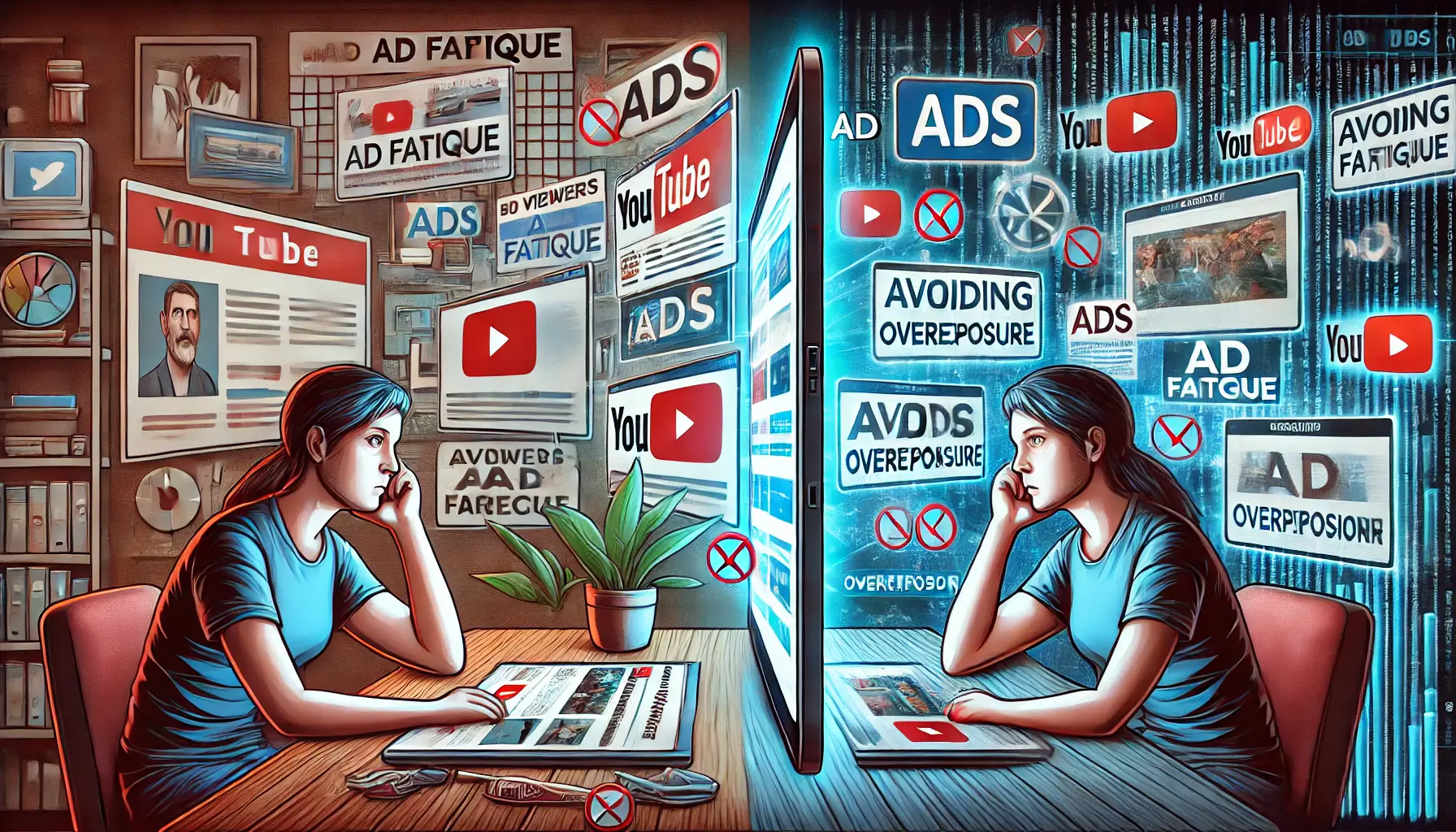
Illustration of avoiding ad fatigue and maintaining a balanced viewer experience in digital marketing.
Avoiding Ad Fatigue and Viewer Annoyance
Overexposure to ads results in ad fatigueA state where viewers become annoyed or disengaged due to repeated exposure to the same advertisement., where viewers become annoyed and disengage.
To avoid this:
- Monitor Performance Metrics: Regularly measure engagement levels, click-through rates, and viewer feedback to detect signs of ad fatigue.
- Rotate Ad Creatives: Introduce fresh ad variations to maintain content freshness and viewer engagement.
- Implement Frequency Capping: Limit the number of times an individual viewer sees your ad within a specific timeframe.
These practices help maintain a positive viewer experience and enhance campaign effectiveness.
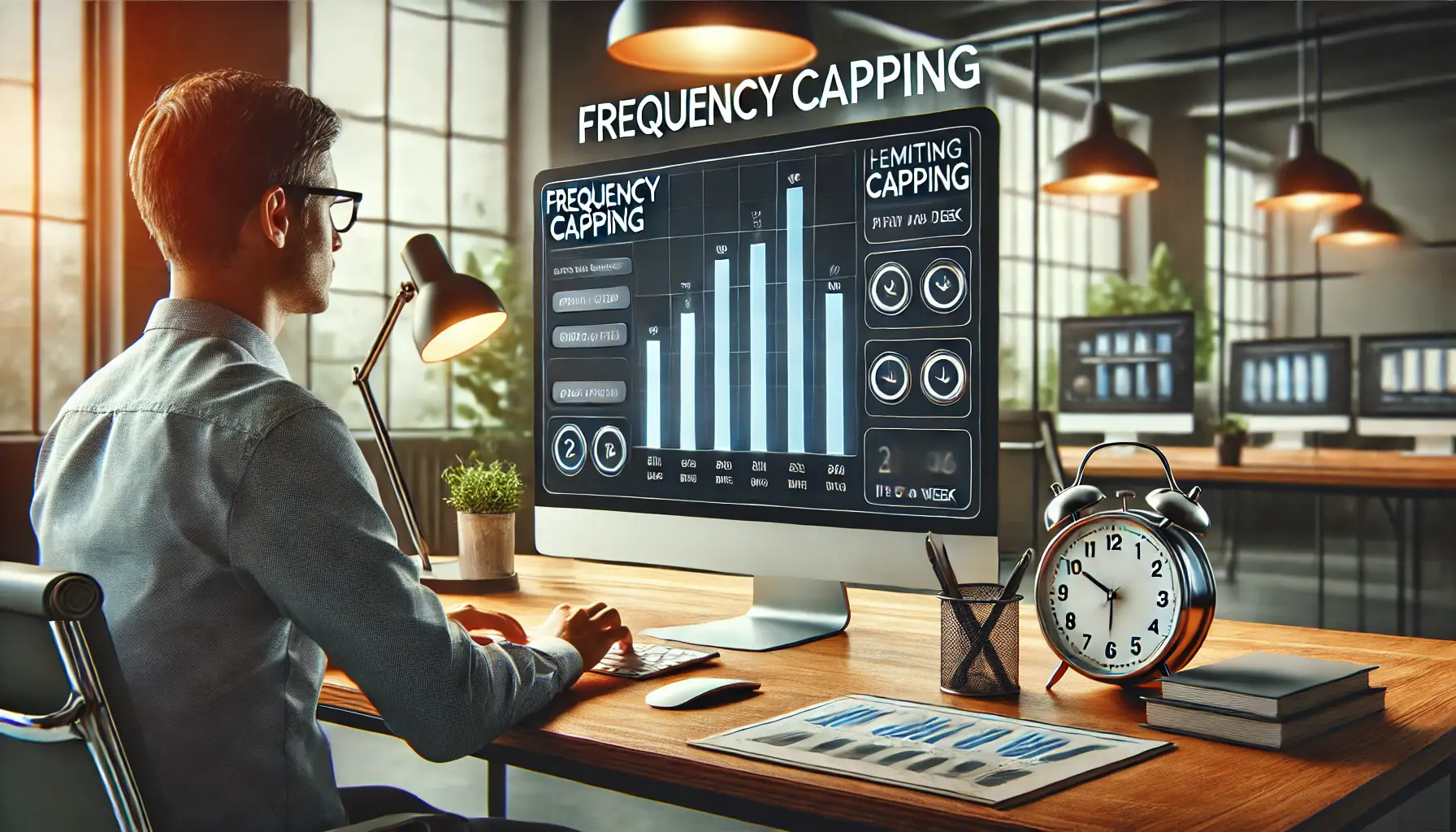
Visual representation of the process of implementing frequency capping techniques in digital advertising.
Implementing Frequency Capping Techniques
Frequency capping is a valuable tool to control ad exposure.
Here’s how to apply it effectively:
- Set Appropriate Caps: Determine the number of impressions per user per day, week, or month based on your campaign goals.
- Leverage Platform Tools: Use YouTube’s frequency capping features to automatically enforce your set limits.
- Adjust Based on Data: Regularly review campaign performance data and fine-tune frequency caps for better results.
By implementing these strategies, your ads are effectively served to the audience without causing annoyance, leading to more successful and impactful YouTube advertising campaigns.
- Monitor performance metrics to identify ad fatigue early.
- Set frequency caps to limit overexposure.
- Rotate ad creatives to maintain viewer interest.
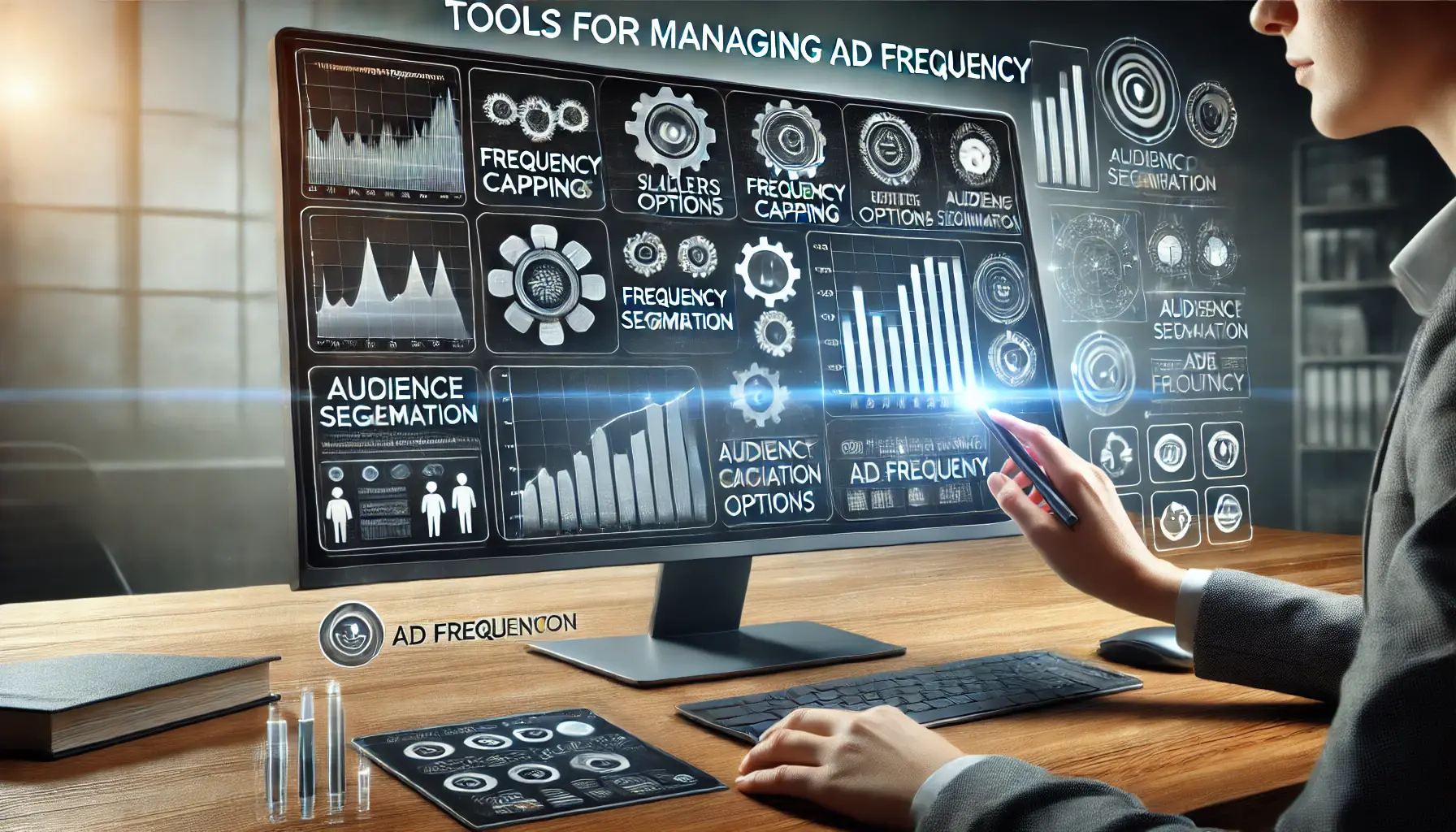
Visual representation of tools and techniques for managing ad frequency in digital advertising.
Tools and Techniques for Managing Ad Frequency
Effectively managing ad frequency on YouTube is essential to optimize viewer engagement and maximize your advertising ROIReturn on Investment; a measure of the profitability of an advertising campaign..
Utilizing the right tools and techniques can help you control how often your ads are shown to the same user, ensuring a balanced and effective campaign.
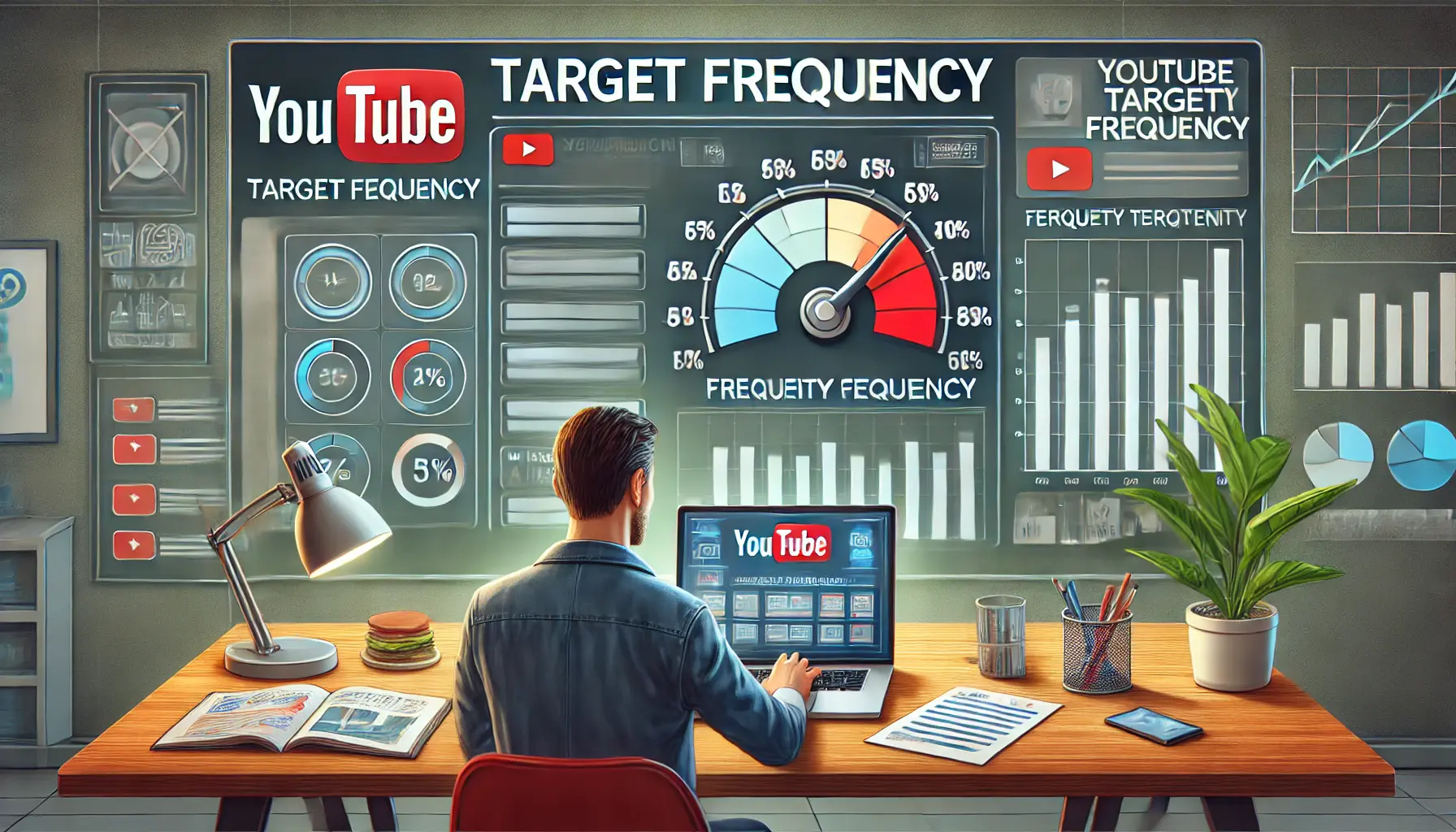
Illustration of using YouTube’s Target Frequency feature to manage ad exposure.
Utilizing YouTube’s Target Frequency Feature
YouTube’s Target FrequencyA tool or setting that allows advertisers to define the desired number of ad exposures per user. feature allows you to set a desired frequency cap for your campaigns.
By specifying how many times a viewer should see your ad within a given timeframe, you can keep viewers interested without overexposure.
- Set Frequency Goals: Define the optimal number of ad exposures per user per week to meet your campaign objectives.
- Automated Optimization: YouTube’s system automatically adjusts ad delivery to meet your specified frequency targets.
- Enhanced Viewer Experience: Controlling ad frequency helps reduce ad fatigue and improve viewer satisfaction.
Target Frequency can help drive more efficient reach and better alignment with your marketing objectives in your campaigns.
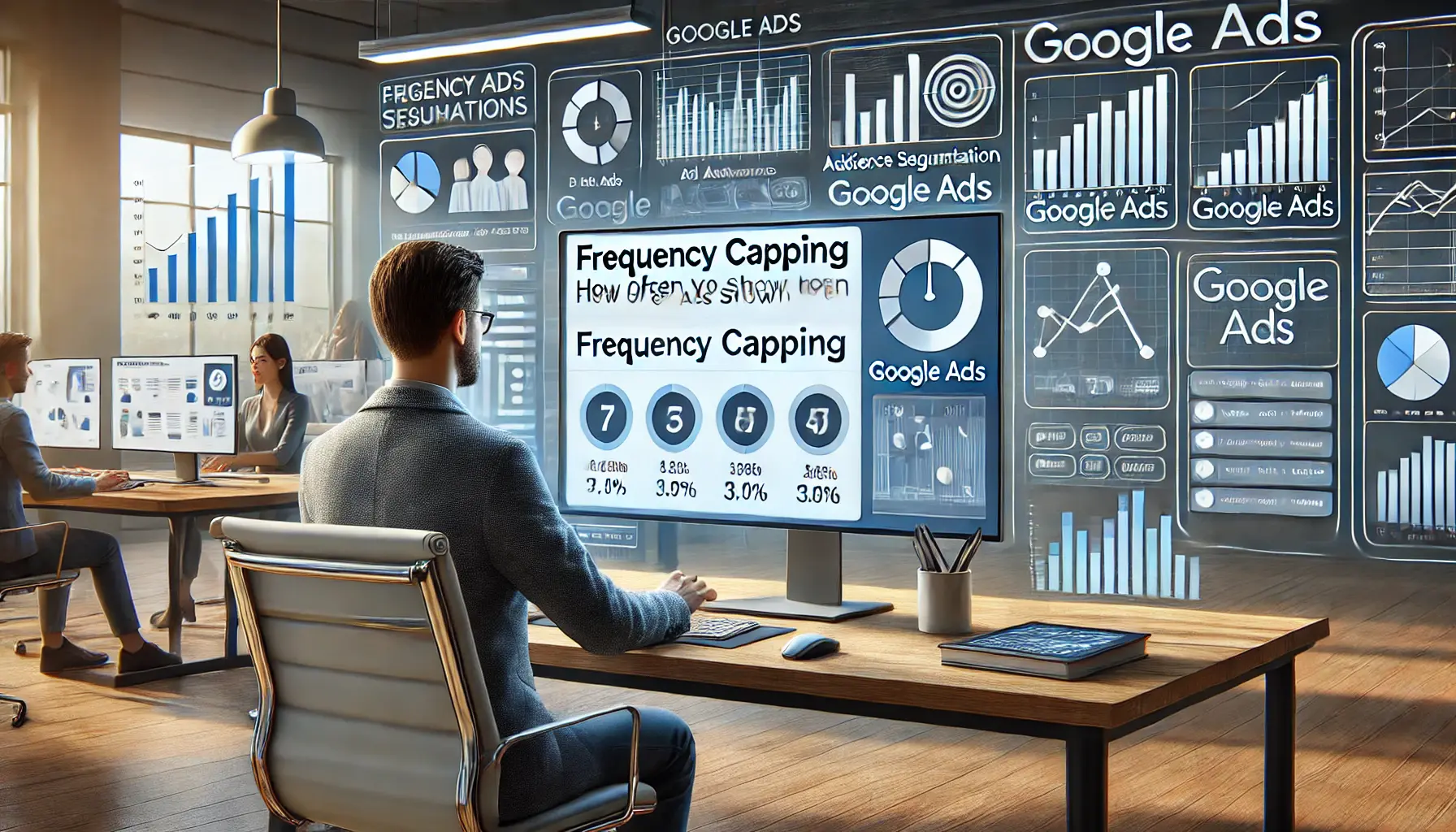
Visual representation of using Google Ads to manage and optimize ad frequency.
Leverage Google Ads to Control Frequencies
With Google Ads, you have great control over the ad frequency of your advertisements on YouTube and other platforms.
By setting frequency cappingA feature that limits the number of times an individual user sees the same ad within a specific timeframe. in Google Ads, you can manage how many times an ad is served to a particular user, preventing overexposure.
- Ad Scheduling: Identify the exact times and days when your ads should appear to achieve maximum impact.
- Audience Segmentation: Set up frequency settings for different audience segments based on their engagement levels and behaviors.
These features help make your advertising more personalized and effective for your audience.

Illustration of the process of monitoring and adjusting ad campaigns for optimal performance.
Monitoring and Adjusting Ad Campaigns
Regular monitoring, editing, and readjustments of your campaigns are crucial.
By tracking key metrics, you can make informed decisions on frequency settings and overall campaign strategies.
- Performance Metrics: Track engagement rates, click-through rates, and conversion data to understand the real performance of your ad frequency.
- A/B Testing: Test various frequency caps and ad creatives to determine the most effective combinations.
- Continuous Optimization: Periodically reassess and adjust your frequency settings based on performance data and shifting audience behaviors.
By managing your ad campaigns proactively, you ensure that your advertising is always relevant and supports your business objectives.
Applying these tools and techniques enables you to manage ad frequency on YouTube for better viewer engagement and a greater return on investment from your advertising campaigns.
YouTube’s Target Frequency feature and Google Ads frequency capping are powerful tools for controlling ad exposure, ensuring optimal viewer engagement and campaign ROI.

Illustration of case studies focused on successful ad frequency management strategies on YouTube.
Case Studies: Effective Ad Frequency Management on YouTube
Understanding how leading brands manage ad frequency on YouTube can provide valuable insights for your campaigns.
Let’s explore some notable examples that demonstrate successful strategies in action.

Illustration of Adidas using video sequencing to engage audiences through a series of progressive ads.
Adidas: Engaging Audiences with Video Sequencing
Adidas effectively utilized YouTube’s video ad sequencing to launch its Nemeziz football shoe.
By delivering a series of ads in a specific order, they guided viewers from awareness to consideration.
- Sequential Storytelling: The campaign began with a bumper ad to grab attention, followed by longer videos providing in-depth product information.
- Targeted Frequency: Ads were served to viewers multiple times to reinforce the message without causing fatigue.
- Enhanced Engagement: This approach resulted in more engaged viewers who gained a deeper understanding of the product’s features.
This case illustrates the effectiveness of controlled ad frequency and sequencing in maintaining viewer interest and driving engagement.

Illustration of Adidas using video sequencing to engage audiences through a series of progressive ads.
Implementing Best Practices for Ad Frequency
Research indicates that excessive ad frequency can diminish return on investment (ROI).
A study by Nielsen found that TV advertisers’ ROI decreased by 41% when frequency exceeded six weekly impressions, accounting for 46% of TV impressions.
To avoid such pitfalls on YouTube:
- Set Frequency Caps: Limit the number of times an individual viewer sees your ad within a specific timeframe to prevent overexposure.
- Monitor Performance Metrics: Regularly assess engagement rates and viewer feedback to adjust frequency settings accordingly.
- Utilize YouTube’s Target Frequency Feature: Leverage platform tools to automate frequency management and optimize ad delivery.
Implementing these best practices can help maintain a positive viewer experience and enhance campaign effectiveness.
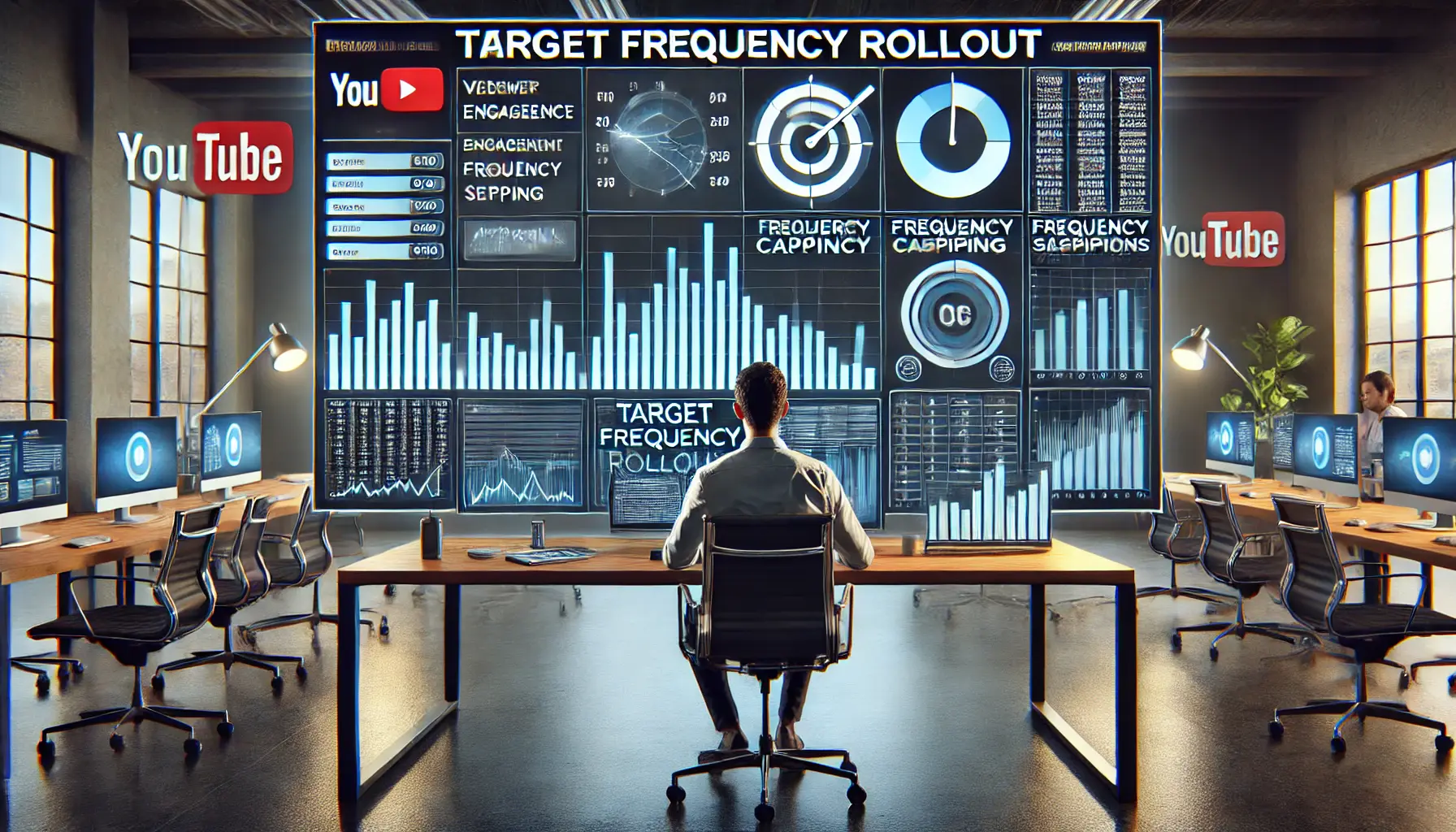
Illustration of insights gained from YouTube’s Target Frequency rollout, optimizing ad campaigns.
Insights from YouTube’s Target Frequency Rollout
Google’s introduction of the target frequency capability for YouTube campaigns allows advertisers to control ad frequency more precisely.
This feature enables setting desired frequency caps, ensuring viewers are not overwhelmed by repetitive ads.
- Improved Viewer Experience: Reducing ad repetition enhances viewer satisfaction and reduces the likelihood of ad fatigue.
- Optimized Ad Spend: Efficient frequency management ensures that budget is utilized effectively to drive maximum ROI.
- Strategic Ad Delivery: Advertisers can align ad frequency with campaign objectives, whether it be brand awareness or conversions.
By adopting such tools and strategies, advertising on YouTube can be more successful and viewer-friendly.
By analyzing these case studies and following the best practices, you can develop a much better approach to managing ad frequency in your YouTube advertising campaigns, leading to better engagement and improved outcomes.
Learning from brands like Adidas demonstrates the value of controlled ad sequencing and frequency management for enhanced viewer engagement and campaign effectiveness.

Illustration of future trends in managing ad frequency on YouTube with AI and machine learning tools.
Future Trends in YouTube Ad Frequency Management
As digital advertising evolves, managing ad frequency on YouTube is becoming increasingly sophisticated.
Staying informed about emerging trends can help you maintain effective and engaging campaigns.

Illustration of enhanced frequency capping solutions for managing ad exposure in digital advertising.
Enhanced Frequency Capping Solutions
YouTube has introduced advanced frequency capping tools that enable advertisers to set granular limits on how frequently their ads are shown to any one user.
This helps maintain a positive viewer experience by preventing overexposure and ad fatigue.
- Target Frequency Feature: Allows advertisers to decide on desired frequency caps to effectively manage ad exposure.
- Improved ROI: Better frequency management ensures resources are utilized more effectively for higher returns.
These advancements optimize your ad delivery, leading to improved campaign performance.

Illustration of the integration of AI and ML in optimizing digital advertising campaigns.
Integration of Artificial Intelligence and Machine Learning
Ad frequency optimization is increasingly reliant on Artificial Intelligence (AIArtificial Intelligence; technology that simulates human intelligence to make decisions or predictions.) and Machine Learning (MLMachine Learning; a subset of AI that uses data to improve decision-making processes over time.).
These technologies analyze user behavior and engagement patterns to determine the optimal number of ad exposures.
- Predictive Analysis: AI predicts user responses to different ad frequencies, providing insights for better decision-making.
- Real-Time Adjustments: ML algorithms automatically adjust ad delivery in real time based on user interactions.
Leveraging AI and ML can help develop more targeted and relevant advertising strategies.
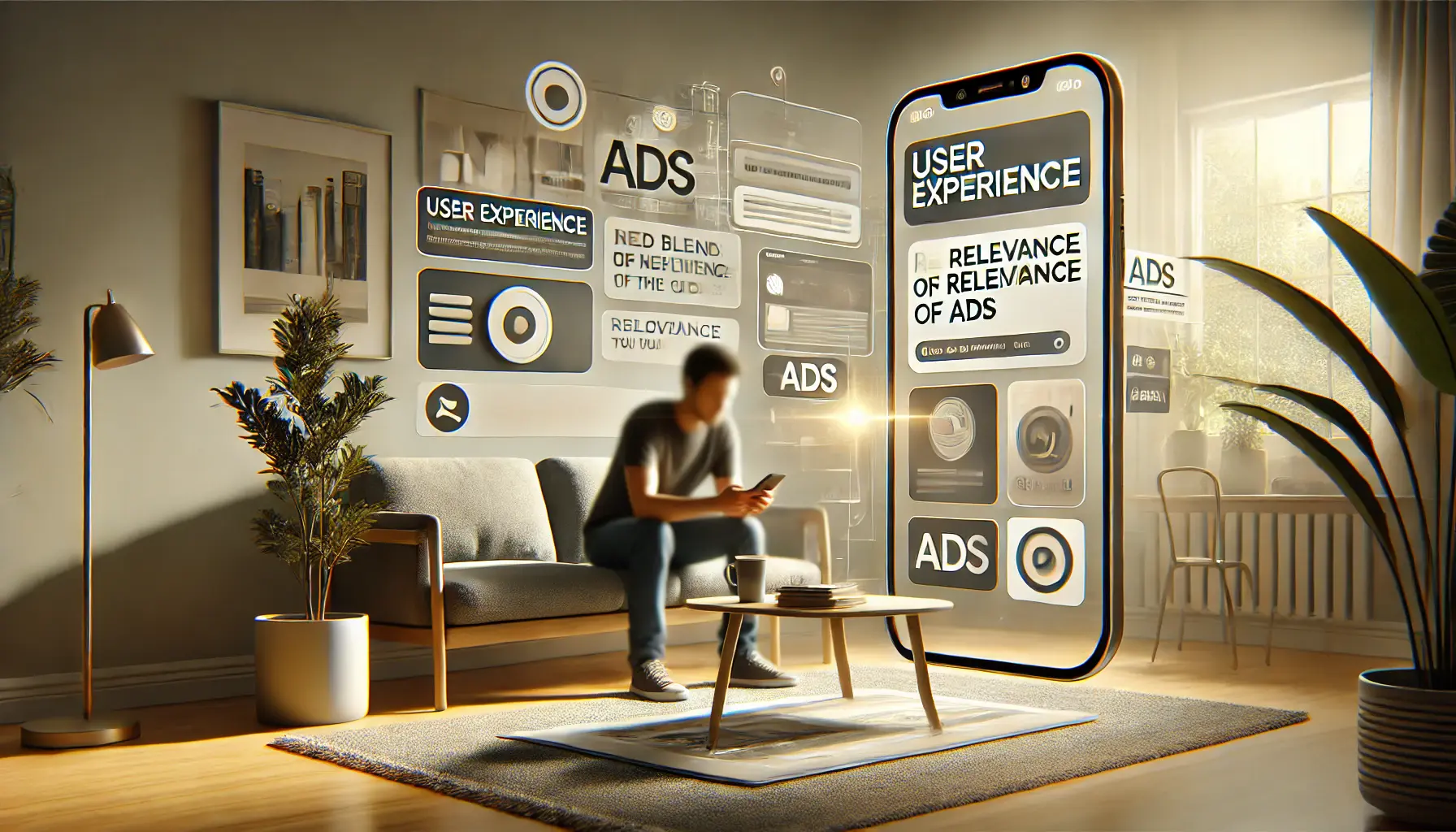
Illustration of the emphasis on user experience and the relevance of ads in digital marketing.
More Emphasis on User Experience and Relevance of Ads
There is growing importance placed on user experience by offering relevant ads that do not disrupt their viewing.
Viewer satisfaction is now a key factor in maintaining engagement with ads.
- Personalized Content: Tailoring ads to individual preferences increases relevance and engagement.
- Non-Intrusive Formats: Utilizing ad formats that integrate seamlessly into the viewing experience.
Focusing on user-centric approaches can improve ad effectiveness and viewer retention.
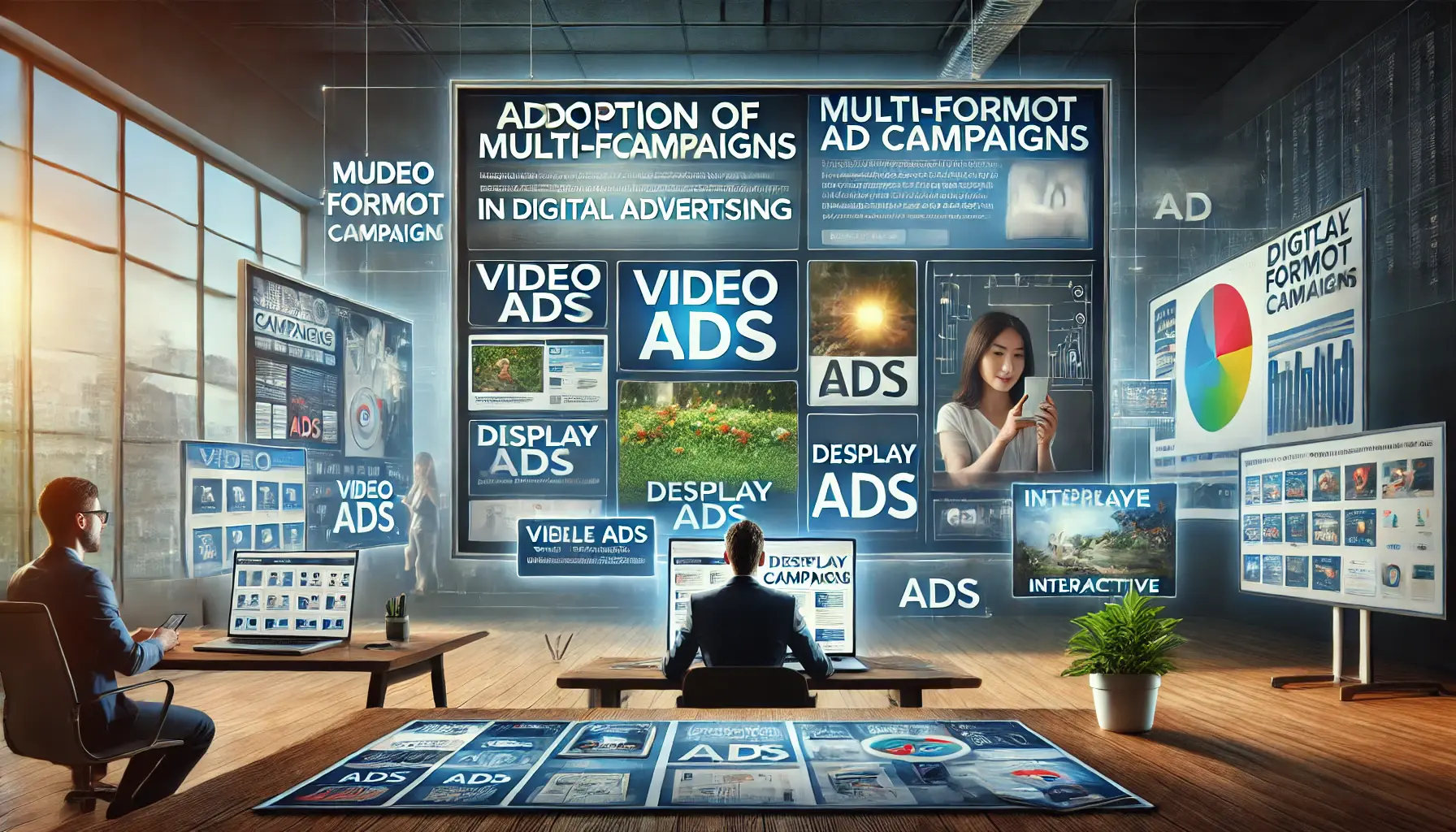
Illustration of the adoption of multi-format campaigns in digital advertising.
Adoption of Multi-Format Campaigns
Advertisers are increasingly adopting multi-format campaigns to reach audiences across various touchpoints.
This approach involves delivering ads in diverse formats to enhance reach and engagement.
- Diverse Ad Formats: Combining video, display, and interactive ads to capture attention.
- Consistent Messaging: Ensuring a unified brand message across all ad formats.
Implementing multi-format campaigns can lead to improved brand awareness and conversion rates.
By staying abreast of these trends and incorporating them into your advertising strategies, you can effectively manage ad frequency on YouTube for more engaging and successful campaigns.
Emerging trends like AI-powered frequency optimization and multi-format campaigns will shape the future of YouTube ad management, enabling advertisers to deliver more impactful campaigns.
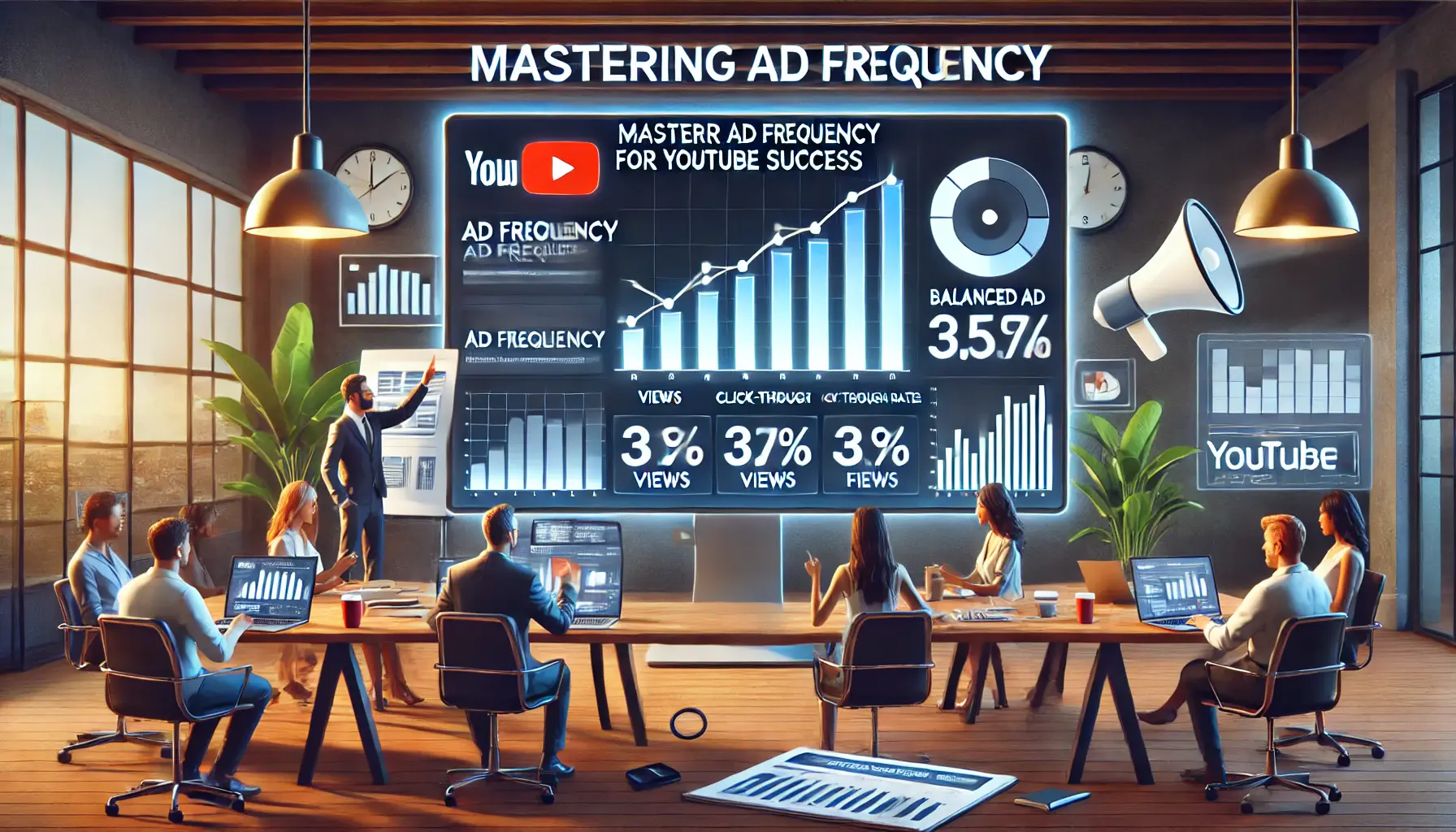
Illustration of mastering ad frequency for YouTube success with positive campaign outcomes.
Conclusion: Mastering Ad Frequency for YouTube Success
Effectively managing ad frequency is essential for creating successful YouTube advertising campaigns.
Throughout this article, we have explored strategies, tools, and case studies that highlight the importance of balancing ad exposure to maintain viewer engagement and achieve your marketing objectives.
Let’s summarize the key takeaways.

Illustration of key lessons learned in digital marketing, focusing on campaign performance and insights.
Key Lessons Learned
Better understanding and control of ad frequency can significantly impact the performance of your campaigns.
Key takeaways include:
- Optimal Ad Frequency: Define the ideal frequency based on campaign objectives, target audience, and ad content quality to avoid overexposure.
- Tools and Technologies: Utilize features like YouTube’s Target Frequency and Google Ads frequency capping to automate and refine ad delivery.
- AI and Machine Learning: Use advanced technologies to predict user behavior and optimize ad delivery in real time.
- User-Centric Approaches: Focus on personalized, non-intrusive ads to enhance user experience and retain viewer engagement.
- Case Studies: Learn from successful brands like Adidas that employed video sequencing and frequency management to boost campaign outcomes.

Illustration of adapting to future trends in digital marketing with futuristic technology and innovative tools.
Adapting to Future Trends
The emerging trends that will shape the future of ad frequency management on YouTube include multi-format campaigns, enhanced frequency capping, and the integration of AI.
Staying ahead of these developments can help you create effective campaigns that truly resonate with your audience.
- Multi-Format Approach: Experiment with video, display, and interactive formats for maximum reach and impact.
- Advanced Tools: Leverage cutting-edge frequency capping solutions for efficient and precise ad delivery.
- Data-Driven Insights: Regularly analyze performance metrics to refine your strategies and improve results.

Illustration of final thoughts and the conclusion of a successful digital marketing campaign.
Final Thoughts
Mastering ad frequency on YouTube requires strategic planning, leveraging advanced tools, and maintaining a focus on user experience.
By implementing the strategies and insights shared in this article, you can optimize your campaigns for higher engagement, better ROI, and long-term success.
In the ever-changing landscape of digital advertising, the ability to adapt to emerging trends is crucial for ensuring the effectiveness of your YouTube ad campaigns.
Take these lessons forward and build impactful strategies to truly connect with your audiences.
Balancing ad frequency is a cornerstone of successful YouTube advertising. Adapting to new tools and trends ensures viewer satisfaction and maximized campaign results.
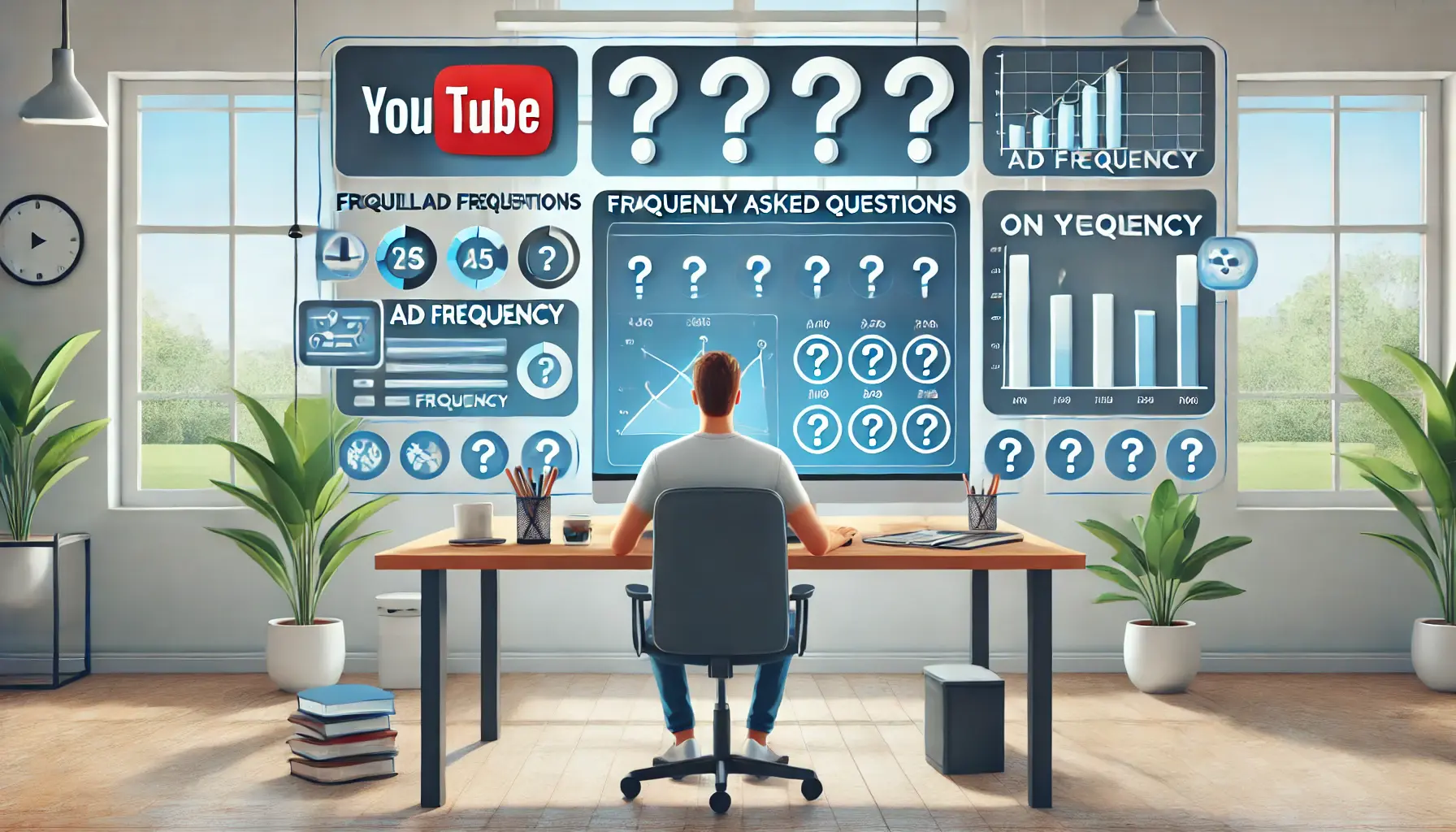
Illustration of frequently asked questions about YouTube ad frequency with a focus on analysis and metrics.
Your campaigns can be managed by an agency specialized in Google Ads, check out our service page.
YouTube Ad Frequency: Frequently Asked Questions
Understanding ad frequency is key to maximizing your YouTube advertising campaigns.
Here are some frequently asked questions and their concise answers to help you use this feature effectively.
Ad frequency refers to the number of times a unique viewer sees your ad during a fixed period.
Proper management prevents viewer fatigue, enhances engagement, and maximizes return on investment.
Utilize YouTube’s Target Frequency feature to set desired weekly ad exposure limits.
The ideal frequency varies; monitor performance metrics to determine what works best for your audience.
Yes, excessive frequency can lead to viewer annoyance and decreased engagement ratesThe level of interaction a viewer has with an advertisement, often measured by actions like clicks or shares..
Moderate frequency can enhance brand recall, while too much may have adverse effects.
Platforms like Google Ads and YouTube Studio offer features to monitor and adjust ad frequency.
Yes, frequency capping allows you to limit how often your ads are shown to the same user.
Balanced frequency maintains a positive user experience; imbalance can lead to dissatisfaction.
